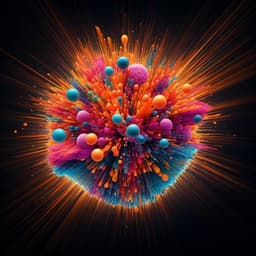
Physics
Ultrafast hydrogen bond dynamics of liquid water revealed by terahertz-induced transient birefringence
H. Zhao, Y. Tan, et al.
Discover how an intense ultrabroadband THz pulse is revealing the complex dynamics of water's hydrogen bond network, thanks to groundbreaking research conducted by Hang Zhao, Yong Tan, Liangliang Zhang, Rui Zhang, Mostafa Shalaby, Cunlin Zhang, Yuejin Zhao, and Xi-Cheng Zhang.
~3 min • Beginner • English
Introduction
Water’s extraordinary properties are widely attributed to its hydrogen bond network. The frequency-dependent dielectric susceptibility of water in the GHz–THz range reflects collective molecular motions, but disentangling the dominant contributions is difficult due to overlapping relaxation and intermolecular modes. Conventional optical Kerr effect measurements are dominated by electronic responses, with weak molecular contributions because water’s low-frequency motions cannot follow optical fields. Terahertz excitation can resonantly drive cooperative low-frequency motions, suggesting that a time-resolved THz Kerr effect could reveal intermolecular hydrogen-bond dynamics. This study asks whether an intense, ultrabroadband THz pulse can directly excite and temporally resolve distinct intermolecular hydrogen bond modes (bending near ~1.8 THz and stretching near ~5.7 THz) in liquid water, and whether the resulting transient birefringence can be decomposed to quantify their competing contributions to polarizability anisotropy.
Literature Review
Prior THz-driven Kerr studies on liquids (DMSO, chloroform, water) established feasibility of tracking molecular dynamics via transient birefringence. Zalden et al. (0.25 THz, single-cycle) observed time-resolved birefringence in water dominated by orientational relaxation, inferring smaller polarizability parallel than perpendicular to the permanent dipole; however, limited THz bandwidth and power restricted access to intermolecular modes. Novelli et al. (narrowband 12.3 THz, FEL) reported a very large third-order response from librational excitation but without time-resolved dynamics due to a long probe pulse. Significant intermolecular modes of liquid water—hydrogen-bond bending (~1.8 THz, 60 cm−1) and stretching (~5.7 THz, 190 cm−1)—have remained unexplored in time-resolved TKE due to strong water absorption at these frequencies (α ≈ 330 cm−1 at 1.8 THz; α ≈ 1201 cm−1 at 5.7 THz) versus lower absorption at 0.25 THz (α ≈ 118 cm−1), and because cuvette containers introduce large Kerr backgrounds and interactions that obscure the water signal. These limitations motivated a high-field, ultrabroadband THz approach with a cuvette-free sample geometry to resolve intermolecular dynamics.
Methodology
Experimental: An intense ultrabroadband THz pump (center frequency ~3.9 THz; spectral content 1–10 THz; peak electric field up to 14.9 MV/cm) excites a gravity-driven, free-flowing water film. An 800 nm probe, polarized at 45° to the THz field, traverses the film to monitor THz-induced transient birefringence via the phase shift of the probe (time-delayed detection). The water film avoids cuvette-induced artifacts and enhances signal-to-noise. The THz field strength is varied to confirm response scaling, and low-pass filters (cutoffs ~18, 9, and 6 THz) are applied to test frequency dependence of the response. Data are normalized to compare across field strengths.
Modeling: The measured birefringence Δn is expressed as the sum of electronic (Δn_e = A B |E(t)|^2) and molecular contributions, the latter consisting of Debye relaxation (Δn_D) and two intermolecular hydrogen-bond vibrations: bending (i=1) and stretching (i=2), Δn_m = Δn_D + Δn_1 + Δn_2. A hydrogen-bond harmonic oscillator model links microscopic perturbations of the dielectric tensor components parallel and perpendicular to the hydrogen bond to macroscopic anisotropy. For bending, the principal perturbation is perpendicular to the bond; for stretching, it is parallel. The anisotropic perturbations driven by the y-polarized THz field are represented by q_i, each following a damped Lorentz oscillator driven by the squared THz field: q¨_i + γ_i q˙_i + ω_i^2 q_i = α_i E^2(t) (i=1 bending, i=2 stretching). Literature values are used for parameters: γ_1 = 115 cm−1, ω_1 = 60 cm−1 (bending); γ_2 = 165 cm−1, ω_2 = 190 cm−1 (stretching). The induced birefringence contributions have opposite signs (Δn_1 < 0; Δn_2 > 0). Frequency-domain analysis defines an effective Kerr coefficient K_eff(ω) = F[Δn(t)]/F[E^2(t)], which for the intermolecular modes is approximated by K_eff(ω) = Σ_i k_i/(ω_i^2 − ω^2 + i γ ω), where k_i are scaling constants derived from fits to experimental data. Simulations decompose the measured signals into electronic, Debye, bending, and stretching components and are compared against measurements under different spectral cutoffs.
Key Findings
- A clear bipolar transient birefringence response is observed in liquid water with pronounced oscillatory features. The response amplitude scales with the square of the THz field, confirming a third-order (Kerr) origin.
- Decomposition attributes the positive polarity to the hydrogen-bond stretching vibration and the negative polarity to the hydrogen-bond bending vibration, demonstrating competing contributions to polarizability anisotropy (parallel vs perpendicular to the hydrogen bond).
- Applying low-pass filters shows strong frequency dependence: reducing the cutoff frequency suppresses the positive lobe more than the negative, consistent with the positive contribution originating from higher-frequency stretching motion.
- Electronic and Debye contributions are minor under these excitation conditions; the molecular response is dominated by intermolecular bending and stretching modes for a broadband pump centered at ~3.9 THz.
- Frequency-domain Kerr coefficient K_eff extracted from data (0.5–10 THz) exhibits a significant peak near ~4.5 THz, attributed to underdamped stretching; bending, being near critically damped, does not show a sharp peak.
- The measured K_eff(ω) is well reproduced by the sum of two Lorentzian-like contributions from bending and stretching: K_eff(ω) ≈ Σ_i k_i/(ω_i^2 − ω^2 + i γ ω), with fitted scaling constants k_1 ≈ −7 × 10^10 C/(V·kg·m) (bending) and k_2 ≈ 6.5 × 10^10 C/(V·kg·m) (stretching).
- Parameter values used for the oscillators (from literature) are γ_1 = 115 cm−1, ω_1 = 60 cm−1 (bending) and γ_2 = 165 cm−1, ω_2 = 190 cm−1 (stretching). The observed time-domain oscillations are primarily due to underdamped stretching.
- The intense, ultrabroadband THz pump (14.9 MV/cm; 1–10 THz; center 3.9 THz) and cuvette-free water film enable high-SNR, time-resolved observation of intermolecular hydrogen-bond dynamics.
Discussion
The results directly address whether intermolecular hydrogen-bond modes in water can be driven and resolved in time using intense, broadband THz fields. The bipolar TKE signal and its decomposition demonstrate that bending and stretching modes contribute with opposite signs to transient polarizability anisotropy. The frequency-dependent behavior under varying spectral cutoffs and the peak in K_eff near ~4.5 THz validate the assignment and the Lorentz oscillator model. The findings clarify that at higher THz driving frequencies (around a few THz), intermolecular vibrations dominate the Kerr response, whereas orientational relaxation dominates for low-frequency (sub-THz) excitation reported previously. Establishing a simple frequency-domain Kerr coefficient expression tied to specific intermolecular modes provides a quantitative link between THz driving and water’s transient structure. Using a free-flowing film eliminates container artifacts, strengthening confidence that the measured signal reflects intrinsic water dynamics.
Conclusion
This work presents the first time-resolved observation of a bipolar THz-induced Kerr effect in liquid water arising from competing intermolecular hydrogen-bond vibrations: negative from bending and positive from stretching. Using an intense, ultrabroadband THz pump and a cuvette-free water film, the study isolates and models the intermolecular contributions, revealing strong frequency dependence and an underdamped stretching resonance that shapes the time-domain oscillations. A compact Kerr coefficient model, expressed as the sum of two damped harmonic responses, quantitatively reproduces the measured spectra. These insights provide a direct, time-resolved view of hydrogen-bond network dynamics and establish a pathway to probing transient water structure with THz fields. Future work can extend to higher THz frequencies to include librational modes (>12 THz) and explore broader temperature or environmental conditions to map hydrogen-bond dynamics across regimes.
Limitations
- The excitation bandwidth (1–10 THz) does not access higher-frequency librational modes (>12 THz), which are expected to contribute at higher driving frequencies.
- The assignment and quantitative modeling rely on literature values for oscillator parameters and a simplified damped harmonic oscillator framework, which may not capture all complexities of the hydrogen-bond network.
- Strong water absorption in the THz range, while mitigated by the free-flowing film, can still influence penetration depth and signal weighting across frequencies.
Related Publications
Explore these studies to deepen your understanding of the subject.







